The encounter took place on a cool winter morning in 2012, in the coastal Indian city of Visakhapatnam. A gentle breeze nipped at the air as Murthy Kantimahanti stood transfixed, staring at a metal trap set up on a dirt trail leading to dense bushes and towering neem trees. Inside the trap was a cat – but no ordinary cat. It was bigger than a house cat, but not as big as a leopard or a tiger. It had a squarish face, relatively small ears for the size of its head, a short tail and curiously webbed feet, like an aquatic animal.
Kantimahanti had just arrived at the Indira Gandhi Zoological Park in the heart of the Seethakonda Reserve Forest, where he worked as a biologist. He was used to seeing native wildlife like Sambar deer, the Asiatic wild dog, the Indian leopard and gaur (also known as Indian bison) ranging within the park's natural enclosures, bordered with hedges and trenches. But this cat was something else entirely.
Kantimahanti's area of research was cataloguing the behaviour of wild dogs that often strayed into the zoo, located as it was in such proximity to the Eastern Ghats, a biodiverse range of mountains along India's south-eastern coast. It is an area where cashew and mango plantations abound. The zoo staff often baited traps to monitor the dogs' numbers and behaviour. On that winter morning, he had received a frantic call from a colleague at the zoo, summoning him to a particular cage by the dirt trail.
“I was fascinated, " he says. “The zoo had laid a trap with beef in it to catch a feral dog. Quite astonishingly, a cat had grabbed at the beef instead, and was ensnared. "
The zoo authorities were puzzled by the animal's webbed feet and strange appearance. This seemed to be no ordinary cat.
Kantimahanti recognised the animal at once. To the trained eye, a fishing cat 's appearance is distinctive, but if ever there was any doubt, there was one trait that helped Kantimahanti identify it instantly – sheer aggression. Having eaten its piece of beef, this cat, a male, lunged fiercely and repeatedly at the bars of the trap.
"If you ask researchers who study the behaviour of fishing cats in the wild, they will tell you that it never backs off, " Kantimahanti says. "Even when they see a human being, they stand their ground. "
The cat was tranquilised, treated for bruises, and released back into the wild. It was the first documented sighting of a fishing cat in coastal Visakhapatnam.
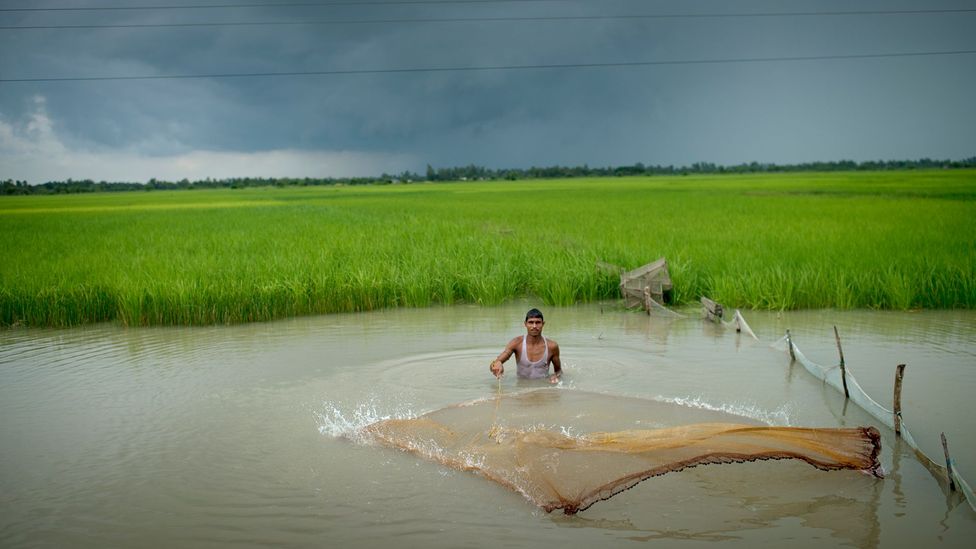
India's remaining wetlands are rapidly being encroached by more intensive human activity (Credit: Jonas Gratzer/Lightrockets/Getty Images)
Until then, fishing cats had only ever been sighted in the state's Coringa Wildlife sanctuary, known for its extensive mangrove forests, four hours away. Very little was known about the fishing cat 's behaviour, despite it being found in 11 countries across Asia.
The encounter helped state authorities realise that fishing cats were a natural part of Andhra Pradesh 's wetland landscape and far more widespread than they’d previously assumed. It sparked one of India's first fishing cat surveys, carried out between 2014 and 2018. Kantimahanti, who went on to found the conservation organisation the Eastern Ghats Wildlife Society, has been working to understand the fishing cat's behaviour ever since.
The first challenge was to find out how widespread the cat was. Researchers from the Wildlife Institute of India and the Eastern Ghats Wildlife Society began an arduous scanning of the Krishna wildlife sanctuary, 150km (93 miles) south of Coringa, as part of a United Nations Development Programme project to document biodiversity in the region. Camera traps from the survey revealed the presence of 10 different species of fishing cat amidst the vast tracts of tidal mangrove forests, though a population estimate for these elusive cats – which relies on clearly identifying an individual cat's distinctive markings – evaded them.
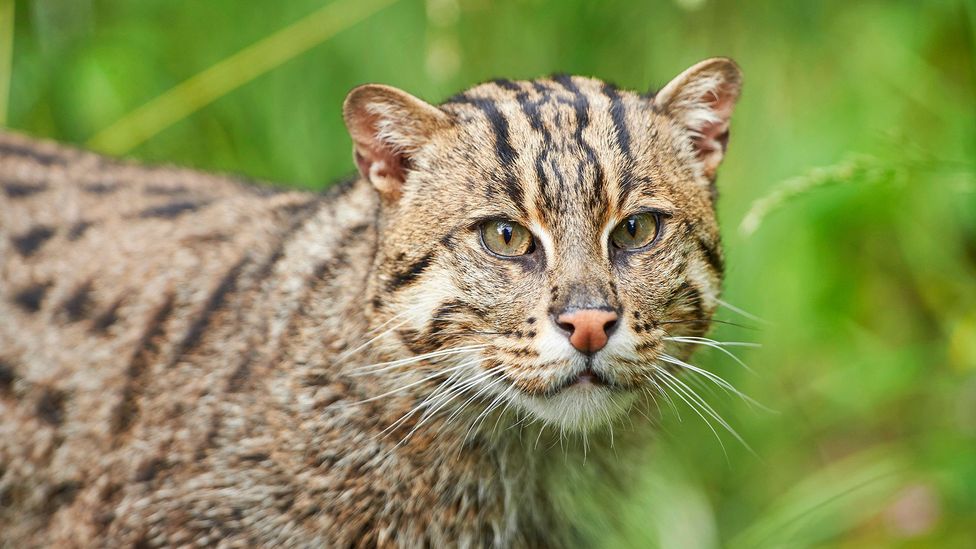
The fishing cat stalks its prey in swamps, wetlands and mangrove forests (Credit: Alamy)
Besides numbers, the census revealed some of the idiosyncrasies of this elusive cat. The survey identified the first known inland fishing cat, found in freshwater habitats along Srikakulam district in northern Andhra Pradesh. Then in December 2020, Kantimahanti was startled to see camera-trap footage of a cat hunting a freshwater non-venomous snake. Fish had been considered the cats' mainstay, and the cats were only thought to prey on other animals when there was a dearth of fish – though on this occasion there was plenty of fish available. In another incident, villagers had assumed a large cat attacking their livestock was a leopard, but it turned out to be a fishing cat. Another camera feed showed a fishing cat being run over by a train while chasing goats.
“The name fishing cat is a misnomer," says Kantimahanti. The cat is a markedly versatile predator. "It can hunt animals bigger than itself, survive anywhere, feed on anything."
Today, growing awareness of the fishing cat in India has sparked a monumental journey towards conservation. Researchers on the trail of this elusive jungle feline are mapping its habits and habitats across the country and studying pollution, human and environmental threats that harm it. They're documenting its effects on climate change and through litigation, using wildlife laws to protect its terrain.
All this, because woven into the story of fishing cats, is that of the wetland habitat itself.
Counting cats
India is home to a rich wetland territory, occupying nearly 5% of its terrain. The Sundarbans in the north-eastern state of West Bengal is the country's most well-known wetland habitat, stretching over 4,230 square kilometres (1,633 sq miles). A total of 42 sites across the country are considered wetlands of international importance due to their biodiversity, according to the Ramsar Convention, an international agreement on wetland conservation.
The fishing cat is usually found in two types of habitat within a wetland: mangroves and marshes. They take refuge in the reed fields – the long-bladed wetland grasses that grow in swamps. "They prefer shallow wetlands and are nest-making cats," says Tiasa Adhya, a Kolkata-based conservationist and co-founder of The Fishing Cat Project. These nests, secluded in the reed fields and in the midst of the gnarled roots of mangroves, are why the habitat is so inseparable from the species. "It's here, where you can find a rich haul of snake-head and cat-fish, on which the fishing cat thrives," says Adhya.
Predators like wolves are known to shape the landscape in which they live through their predation, but the extent to which the fishing cat influences the nature of the wetlands remains unknown. What is clear, is that a healthy population of fishing cats means a healthy environment to sustain them.
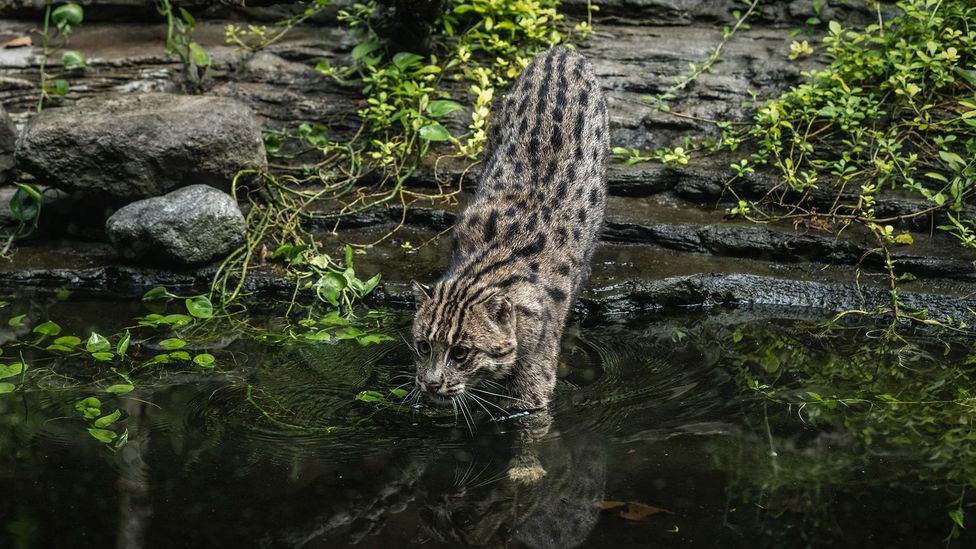
Though the cats range across 11 countries, very little is known about them (Credit: Ulat Ifanstasi/Getty Images)
In one these wetlands, at Chilika Lake in the north-eastern state of Odisha, India's first census for fishing cats outside of its protected reserve forest areas is now underway. "Fishing cats inhabit the extensive deltas and flood plains of river systems, the shallow wetlands connected to rivers in South and South East Asia," she says.
Being a nocturnal animal, they are more likely to be caught on camera traps than by eye during the day. Over a hundred camera traps are to be left in Chilika lake for 30 days. They're focusing more on the freshwater dominant areas of the lake, says Adhya, setting up the cameras in areas where they've spotted pawprints, or pugmarks. Setting up one camera trap can take up to two hours, and Adhya's team has recruited local people to help and put out word among the 200,000 strong fishing community in the area so that the camera traps remain undisturbed.
This census is up against the same challenges as the first surveys of fishing cat numbers. Estimating the population of fishing cats is tricky as it relies on getting a clear picture of the cat to analyse its subtle but distinctive body marks, made up of spots, stripes and patches.
Growing threats
Adhya has been observing fishing cats since 2010, ever since she chanced upon its pugmark in the wild as a researcher in the Sunderbans. The footprint intrigued her; it was roughly the size of a dog 's paw, but smaller than that of a tiger's. She learnt that fishing cats were integral to wetlands, but there was little awareness about them, even amidst local communities. And in recent years, researchers have noted several threats.
The first comes from humans: wetlands directly and indirectly support hundreds of thousands of people, providing livelihoods to fisherfolk, indigenous communities and farmers. There are inevitably moments of conflict. Retaliatory killings of fishing cats spurred by human conflict were well known in West Bengal. Adhya launched awareness campaigns and enlisted the help of locals to prevent poachers from hunting fishing cats for meat, which was being sold in local markets. Over the years, she says these efforts have helped mitigate conflict. "While there are still road kills, the retaliatory killing of fishing cats has significantly reduced," she says.
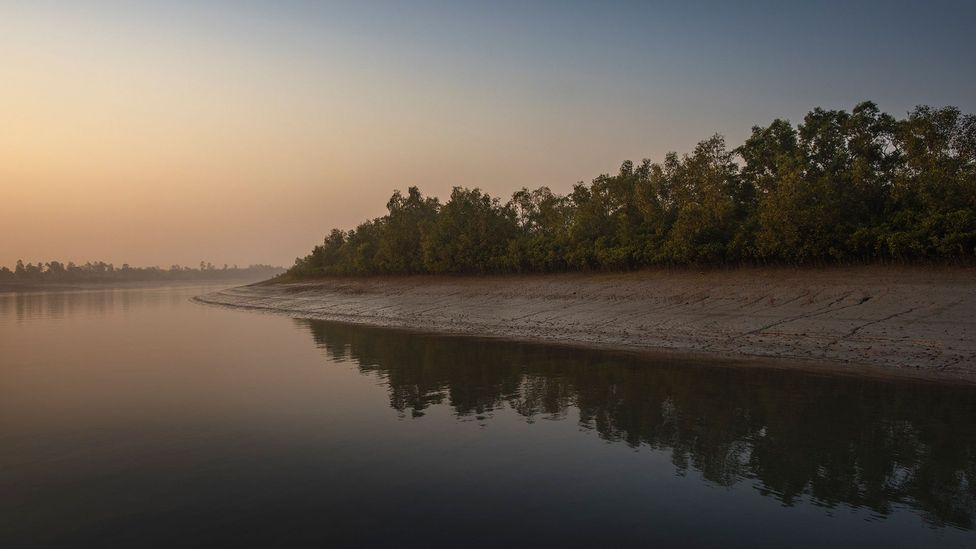
The Sundarbans, in the east of India, is one of the largest remaining wetlands in India (Credit: Jonas Gratzer/Getty Images)
Another threat facing the cat is aquaculture. In recent years, in wetlands across the country, this has become a menace, Kantimahanti says. "People dig ponds, add chemical feed so that naturally occurring fish and prawns grow bigger and fetch better rates in the market. This alters the natural salinity of the soil."
Aquaculture often leads to increased conflict between humans and fishing cats. Lured by the giant fish, the cats that come to hunt often end up in aggressive face-offs with humans. After a few years, the ponds are abandoned when the water table is too polluted, and the aquaculture farmers move on to a different patch, leaving coastal Andhra Pradesh studded with the abandoned farms.
Other threats involve illegal sand mining and cropping along riverbeds. "Villagers growing crops along the riverine buffer [100-500 m alongside the river] affects the inland fishing cat, because this slip of vegetation is an important habitat," says Kantimahanti. "Protection of this riverine buffer is quite a challenge for us."
Another escalating issue is urbanisation. "Wetlands are mostly disregarded as wastelands in development policies," says Adhya. The Asian Waterbird Census, held in January every year is a part of a global initiative that surveys wetlands, has established that India's wetlands are rapidly shrinking because of urbanisation.
Wetland terrain can often be deceptive, Adhya explains. The fluctuating water level is seasonal – for six months every year, the marshes are flooded with water, but the rest of time they may appear dry but the water table lurks close beneath the soil. Most of the development happens in the dry season, when it is mistaken for barren land, to the detriment of both the cats and the developers, who end up with flooded land. "Habitat destruction is one of the biggest threats to the fishing cat," says Adhya.
India does have laws to protect its wetlands. Under the Wildlife Protection Act of 1972, wetlands are categorised as protected areas, especially within national parks. But researchers say that there's a significant portion of wetland ecosystem that falls outside of these protected zones.
From 2012, activists have been lodging legal petitions against urban development in these areas, citing the destruction of habitat of the fishing cat as one of the primary reasons for the need for protection. Researchers hope that the fishing cat census across India could prevent the further destruction of these ecosystems. Kantimahanti, meanwhile, would also like to see a comprehensive national law protecting all wetlands.
Healthy mangroves, healthy cats
Mangrove forests depend on a delicate balance to survive, says Giridhar Malla, a PhD researcher from the Wildlife Institute of India, who has been studying the fishing cat along the Godavari River delta in Andhra Pradesh, and its links to climate change since 2013. He has documented 15 species of fishing cat in the area, monitoring their behaviour, especially during lunar phases. Everything in a mangrove ecosystem depends on the ebb and flow of water, which is linked to the tides governed by the lunar phases.
"The fishing cat hunts during low tide," says Malla. The cats wait tirelessly for the conditions to hunt to be exactly right. During high tide, the surge of water brings in the fish, but the water must ebb for the fishing cat to hunt. Malla says he observed a fishing cat that had waited eight hours until low tide to catch its fish. "This is one stubborn, unique cat," he says.
The health of the mangroves is inextricably linked to the health of the fishing cat, he says. While the mangrove habitat supports the cat, it also acts as a carbon sink, sequestering four times as much carbon as other tree species. He's currently studying its role in mitigating climate change. "Blindly planting mangroves isn’t the answer," says Kantimahanti, who often works closely with Malla. The trees won't survive without freshwater, and have to be planted in the right habitat.
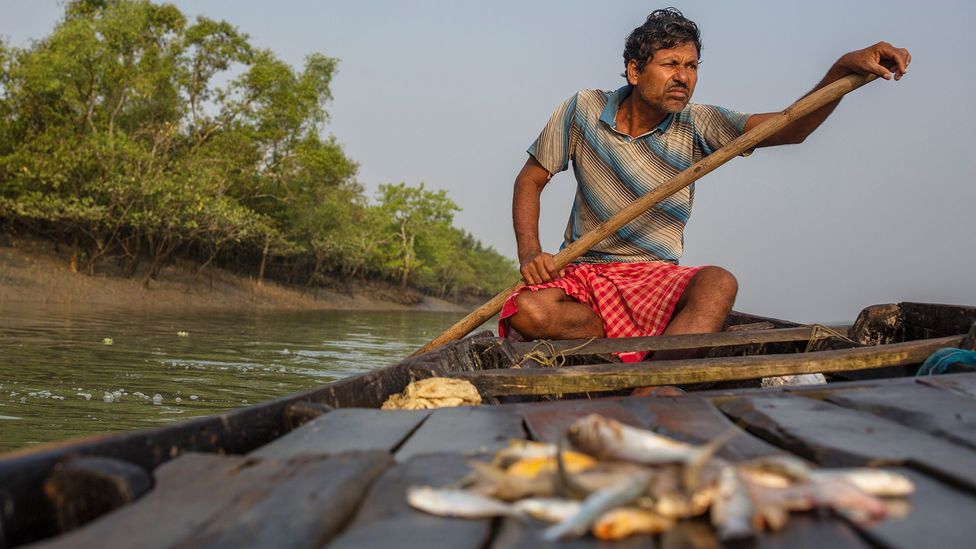
Fishing communities have targeted the cats in the past, seeing it as a pest which steals precious fish (Credit: Jonas Gratzer/Getty Images)
The absence of buffer land either side of the river is affecting the growth of mangroves too, because cropping prevents freshwater that they need from reaching the mangrove forests. Indiscriminate building of dams, which has become so much a part of India's industrial growth, can cause this fragile ecosystem considerable stress as well, says Malla. He's currently petitioning authorities to allow a small amount of water downstream, to prevent the loss of mangrove cover.
"When mangrove seedlings drop into the mud, they need freshwater to germinate and thrive," he says. The Godavari River, where Malla does his field work, is the second largest river in India, after the Ganges. In the past decades, the river has been dammed in several places, reducing freshwater flow in the area. The impacts of the dams include coastal erosion, as they reduce the flow of sediment to river deltas . "Less water to the mangroves could mean declining fish stock, because it affects the spawning areas for the fish," says Malla. "It has a direct impact on livelihoods of fishers."
Since greater awareness was needed of the intertwined fate of mangroves and fishing cats, in 2016, Malla started an initiative called Children for Fishing Cats. Children tend to be easier to educate than adults, he says, and they have helped mitigate conflict situations by identifying the cat and advising their parents against harming it. Malla has since published a children's book about a fishing cat's journey in the wild and designed a board game called The Fishing Cat and the Creek. If a player lands in a mangrove patch after a high tide during a full moon, their fishing cat will have access to the richest haul of fish. The fishing cat that feeds the most wins. Feedback on the board game from the fishing communities in area who have played and enjoyed it has largely been positive, says Malla, and has helped deepen understanding.
Like Malla, researchers across India working on conserving fishing cat habitat and protecting its species have found it beneficial to embrace local communities. "Every wetland patch supports marginalised communities," says Adhya. A preprint paper she has co-authored on local communities' dependency on the wetland ecosystem reveals that 72% of the respondents in Jhakari, a village in West Bengal, depend on the wetlands for their primary livelihood.
The fishing cat, on the other hand, may prove to be a hardier species than first thought. Though the IUCN has categorised the fishing cat as vulnerable, researchers studying these cats across Asia now marvel at how adaptable it really is. Anya Ratnayaka is a Sri Lankan researcher who has been studying the fishing cat 's behaviour and adaptation in a completely urban environment.
"Twenty square kilometres of Colombo, the capital of Sri Lanka, has been built on wetlands," she says. "The fishing cat has proved that it can co-exist with humans, even in this urban wetland habitat."
Her work began in 2015, after escalating conflict incidents involving the fishing cat. "People would pick up abandoned kittens from the city, thinking they were domestic cats, but quickly return them to authorities, startled by how aggressive they were," she says.
In the same year, a fishing cat was caught on camera, stealing expensive Japanese koi fish from a pond. Ratnayaka set up 10 camera traps in different locations, and for months, attempted to follow this cat across the cityscape after tagging it with a GPS device. "I was stunned. It went everywhere," she says. "It visited people's gardens, sunned itself on rooftops, fed from private ponds. It even visited the premises of a movie theatre in the heart of the city, quite fittingly, during the premiere of the Monkey Kingdom."
If fishing cats are to have a home alongside humans in a rapidly developing world, this ingenuity could prove essential to its survival.
--
Join one million Future fans by liking us on Facebook, or follow us on Twitter or Instagram.
If you liked this story, sign up for the weekly bbc.com features newsletter, called "The Essential List". A handpicked selection of stories from BBC Future, Culture, Worklife, and Travel, delivered to your inbox every Friday.
"save" - Google News
April 16, 2021 at 02:00PM
https://ift.tt/3eeRhpH
The fight to save India's most elusive cat - BBC News
"save" - Google News
https://ift.tt/2SvBSrf
https://ift.tt/2zJxCxA
Bagikan Berita Ini















0 Response to "The fight to save India's most elusive cat - BBC News"
Post a Comment